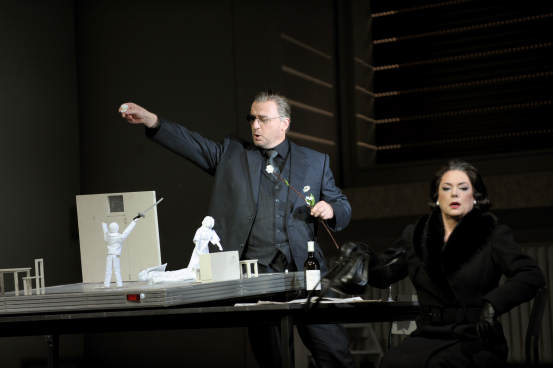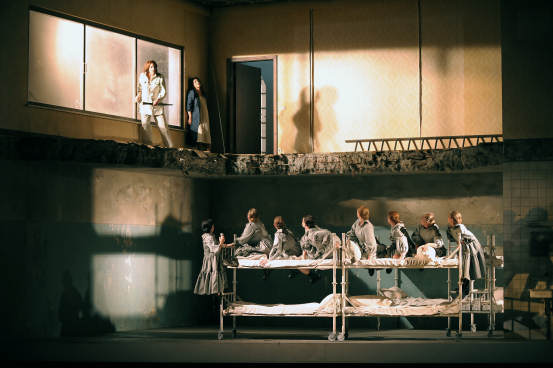Other Links
Editorial Board
- Editor - Bill Kenny
Founder - Len Mullenger
Google Site Search
SEEN
AND HEARD INTERNATIONAL OPERA REVIEW
Wagner, Die Walküre: (New
production) Soloists, Hamburg Philharmonic Orchestra.
Conductor: Simone Young. Staatsoper Hamburg. 23.10.2008 (JPr)
Act III probably will make more sense when Claus Guth’s entire
concept for the whole Ring Cycle become available. Initial
thoughts were of a bombed out and distressed orphanage with the
pasty-faced Valkyries are incarcerated and to which the only means
of access is an upper level doorway and a ladder. There are
washbasins stage-left and some mirrors –which may allow the
Valkyries to be spied on in the manner familiar to devotees of ‘The
Truman Show’ or the TV-series ‘Lost’.
Production by Claus Guth, Sets and Costumes by Christian
Schmidt.

There is a valid argument to the Bayreuth tradition of staging a new
production of the Ring in its entirety and then refining it
over a period of years. I myself however, get
great enjoyment in other opera houses watching a new Ring
develop over a longer stretch of time, opera by opera, until a Cycle
is complete – or the project abandoned, as it has been on at least
four occasions in my experience. I hope that that never been down to
anything I have written because although I say
this rather tongue-in-cheek, it is certainly true that I was once
berated by a Wagner authority for the part I apparently played in
driving an esteemed British Wagner director to seek work mainly
abroad. Unbelievable perhaps, but genuine thoughI can’t think any
critic in any form has that power these days. Certainly not me.
I came to Hamburg for the second instalment in the new Ring
Cycle by director Claus Guth who has already in his short career
staged Der fliegende Holländer at Bayreuth. In March I
reported on Das Rheingold (See
Review) and felt a underwhelmed and wary of directorial
heavy-handedness. The action was played-out in a doll’s house with
Wotan as the director of an expressionist film.
As the curtain rises for Die Walküre , the sets and costumes
by Christian Schmidt make very few references to Das
Rheingold and time has clearly moved on. Later the large
circular set for Rheingold - Wotan’s attic, as I described
it – becomes a model set up by one wall of Wotan’s plush stylish
new office. There are some other model sets scattered around to show
that Wotan has come along way from his earlier home movies and is
now in the big league. Quite where this concept is going remains
unclear but perhaps the programme makes two long references to ‘The
Truman Show’ - Jim Carrey 1998 film in which he played Truman
Burbank whose life is a fake one. The place where Burbank lives is
actually a big studio and there are cameras everywhere. His wife,
friends and everyone around him are all actors playing out their
roles in the world’s most popular TV-series ‘The Truman Show’.
Burbank believes he is an ordinary guy with an ordinary life but he
is being exploited for the consumers of ‘fly on the wall’ TV until
the day he finds out the truth. Siegfried as Truman Burbank then?
Only time will tell?
Act I takes place on a large version of the illuminated panel that
Wotan has in his office in the next Act, in which he has a
cardboard cut out of the set and model characters to manipulate.
Everything is white, there is an entrance and doorway, a table, two
chairs and a stool and a small cooking area. Sieglinde is in dowdy
plain blue, Siegmund is a hoodie and Hunding wears black leather.
Wotan, spear in hand, strides across the front of the stage and
clicks his fingers to start the action.
As previously described, Act II takes place in Wotan’s office
complete with large shuttered windows and a radiator. The room is
dominated by the set of Wotan’s ‘world’ near to one wall and there
is another table and more chairs. These chairs gave me my only real
moment of ‘directoritis’ in this otherwise compelling evening as it
was obvious from the outset that they would be thrown around when
Wotan becomes angry whilst explaining his plight to Brünnhilde. …
They were. The rest of Act II takes place below the large panel
that seen in the first Act. Both Wotan and Fricka are expensively
dressed and Brünnhilde’s costume appeared to be partly safari suit
and army fatigues.

This Walküre had already suffered one casualty when the
promised Brünnhilde, Lisa Gasteen, cancelled her performances
through illness. Then on the first night, Falk Struckmann
apparently lost his voice and although he performed the role on
stage, his music was sung from the pit by Thomas J Mayer, a member
of the Hamburg State Opera ensemble. For the second night, described
as Première B, in a charming apology prior to the performance, a
spokesman announced there would be another ‘variation’ and that
Mayer would not only sing Wotan but would act the role too,
although he would be unable to offer the complete performance that
the director originally intended.
As a replacement, Mayer was not a totally unknown quantity as he had
recently sung the role in Karlsruhe. Highly experienced, he was
preparing the four villains in Les Contes d’Hoffmann in early
November at Hamburg as well as standing by for Wotan. Quite simply
however, his was the finest Die Walküre since … well
I cannot really remember many better. He possesses a bass-baritonal
voice that is smooth and effortless from bottom to top, clear
diction and great dramatic skills. With long-hair and beard he
resembled a young John Tomlinson both in character and vocal attack
but even Tomlinson, as wonderful a Wotan as he is, even in his
early days, never sung the role with Mayer’s apparent ease.
As Brünnhilde we had the rare privilege of hearing once again the
incomparable Deborah Polaski. I have to remark that she will soon be
entering her seventh decade and that fact alone made her lively
athletic and tomboyish Valkyrie all the more remarkable. In Act II
she ‘Hojotoho’-ed clambering through a large window and in Act III
she went up and down a rickety ladder a number of times, stopping
at least once to sing as she did so. Her voice shows little wear and
tear and is still bright at the top and well by her
characteristically warm chest register. Her ‘War es so schmälich’
was emotionally draining and her ‘Du zeugtest ein edles Geschlecht’
suitably conspiratorial. With Mayer’s joyful, yet heartfelt, ‘Leb’
wohl, du kühnes, herrliches Kind!’ this made for a rapturous final
scene which was not only the natural culmination of the entire
evening but gave us heart-stopping moments for which the rest of the
opera seemed merely the prelude.Finally Brünnhilde settled down on
the floor, took her boots off and as Wotan evoked Loge real flames
flickered to life to frame the sleeping Valkyrie.
Mikhail Petrenko was a rather bland Hunding singing well but more
eloquently than menacingly, Stuart Skelton was a lyrical, effortless
Siegmund though his tone lacked baritonal warmth. He is not much of
an actor either unfortunately and just often just seemed to stomp
around the stage. The mezzo, Yvonne Naef was miscast as Sieglinde
and her voice was often gratingly sharp. There was choppy, poorly
supported, phrasing and her best moments were her final ecstatic
outpouring of ‘O hehrstes Wunder!’ which was too little, too late,
for me. Fricka is the role to which Naef’s voice is probably better
suited but here the goddess of marriage was sung with great poise
and restraint by Jeanne Piland. The Valkyries seemed well chosen and
they enjoyed their pillow fights as part of some demanding
choreography involving their bunkbeds. Of course their chatter about
horses and heroes was just fantasy or delusion.
Loth though I am to find any criticism in
Simone Young’s reading of the score I felt that Act I and II were
almost something to be got out of the way in order to arrive at her
sublime Act III: and maybe she will give a more fully integrated
performance at some time in the future. Yet right from the beginning
with that ominous tread so obviously later adopted by Mahler, hers
was a vigorous, far from a typically stodgy Germanic interpretation.
There was no lack of gravity and there were many moments when she
let the long lines of Wagner’s melody cast their spells. The Hamburg
Philharmonic played well throughout even if the tone of the brass
particularly, sounded a little unrelenting from my seat in the
front stalls. Simone Young has a firm grasp of Wagnerian progression
and there was much illuminating and imaginative detail throughout an
engrossing evening. The conductor and her orchestra – who were all
brought on stage at the end - thoroughly deserved the ovation they
received. Siegfried cannot come along quickly enough for me.
Pictures © Monika Rittershaus
Back
to Top
Cumulative Index Page
